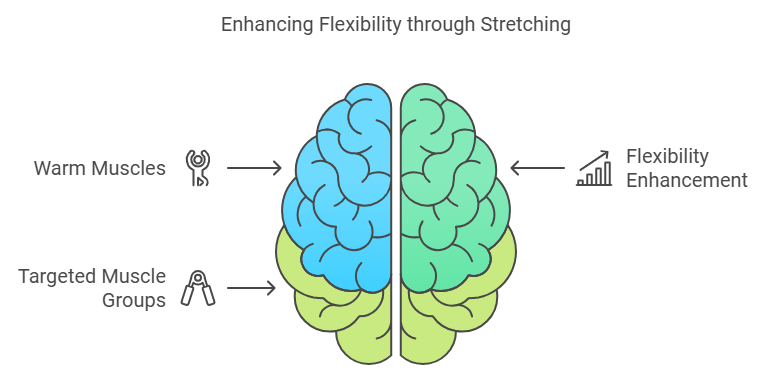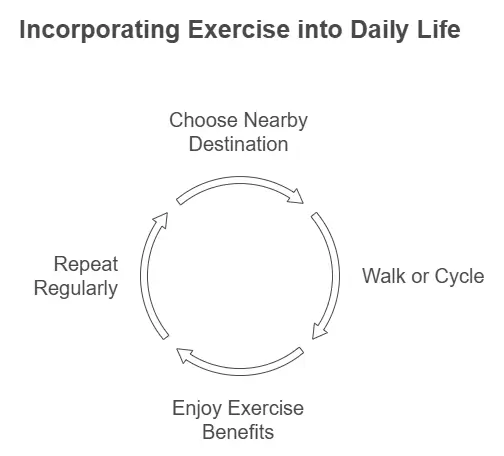
This document serves as a comprehensive guide to creating and maintaining a fitness routine that suits your lifestyle and fitness level. It covers essential components of exercise, including warm-ups, aerobic activities, strength training, flexibility, and balance exercises. Additionally, it provides practical tips for fitting exercise into a busy schedule, ensuring that anyone can incorporate physical activity into their daily lives.

Part 1: Creating an Exercise Routine
Tailoring Your Routine
To create an effective exercise routine, it is crucial to tailor it to your experience level. Start slowly and gradually increase the intensity of your workouts. Determine the right number of repetitions for strength training based on your fitness level and goals.

Warm-Up
Always begin your workout with a 5-10 minute warm-up to prepare your muscles for exercise. Focus on the specific muscles you will be using during your workout. Examples of warm-up activities include light jogging, dynamic stretches, or jumping jacks.

Aerobic Exercise
Aim for at least 30 minutes of moderate-intensity aerobic exercise each day. If this seems daunting, break it up into manageable chunks throughout the day, such as three 10-minute sessions.

Strength Training
Incorporate strength training into your routine at least twice a week. Sample upper and lower body workouts can help you get started. Remember to allow adequate rest time between sets to promote muscle recovery.

Variety
To keep your routine engaging and effective, mix up your exercises regularly. This not only prevents boredom but also engages different muscle groups. Consider trying new activities or varying the intensity and duration of your workouts.

Cool-Down
After your workout, take 5-10 minutes to cool down. This can include a gentle walk followed by targeted stretches to help your muscles recover and improve flexibility.

Part 2: Getting Aerobic Exercise
Walking and Jogging
Walking and jogging are excellent everyday activities. For those with joint issues, consider modifications such as walking on softer surfaces or using supportive footwear.

Jumping Rope
Jumping rope is a fantastic cardio workout. Start with shorter intervals and gradually increase the duration as your fitness improves.

Jumping Jacks
Jumping jacks are an effective cardio exercise. Follow a step-by-step guide to ensure proper form and gradually increase the duration of your sets.

Bike Rides
Begin with easy bike rides and progressively increase your speed and distance. Set target distances and times to challenge yourself.

Swimming
Swimming provides a full-body workout. Aim to swim laps for at least 20 minutes, and consider modifications for lower-impact options if needed.

Running
Once you feel comfortable with other activities, ease into running. Gradually increase your running time each week to build endurance.

Interval Training
Explore interval training by alternating between high-intensity sprints and lower-intensity walking. This method can enhance cardiovascular fitness and endurance.

Part 3: Learning Strengthening Exercises
Push-Ups
Learn how to perform push-ups correctly, focusing on proper form and breathing. Variations can target different muscle groups.

Plank
Holding a plank is excellent for core strength. Focus on maintaining proper form and gradually increase your hold time as you build strength.

Crunches
Perform crunches with slow, controlled movements to engage your core effectively. Proper form is essential to avoid injury.

Bridges
Bridges target the glutes and core muscles. Explore variations to increase the difficulty as you progress.

Squats
Squats are fundamental for lower body strength. Follow detailed instructions to ensure proper form and alignment.

Burpees
Burpees provide a full-body workout. Follow a step-by-step guide to master this challenging exercise.

Weights
Incorporate free weights or gym equipment to add intensity to your strength training. Start with lighter weights and focus on proper form.

Part 4: Boosting Your Balance and Flexibility
Stretching
Stretch warm muscles after your workout to enhance flexibility. Include various stretches targeting different muscle groups.

Yoga
Yoga is beneficial for balance, flexibility, concentration, and stress management. Consider taking classes or practicing at home.

Pilates
Pilates consists of movements that improve aerobic capacity, balance, and flexibility. Join a group or practice at home for the best results.

Dancing
Dancing is a fun way to improve flexibility, endurance, and coordination. Find ways to incorporate dance into your routine.

Tai Chi
Tai Chi is a low-impact exercise that promotes balance, flexibility, concentration, and stress management.

Part 5: Fitting Exercise into a Busy Schedule
Time Management
Identify small chunks of time throughout your day for exercise. Look for opportunities to incorporate physical activity into your daily routine.

Reduce Sitting Time
Minimize the time spent sitting by using standing desks, exercise balls, and taking regular breaks to walk around.

Stairs over Elevators
Opt for stairs instead of elevators whenever possible. Start with manageable sets and gradually increase your activity level.

Walking and Cycling
Encourage walking or cycling to nearby destinations as a way to incorporate exercise into your daily life.

Discover more from TEESHSH COOL
Subscribe to get the latest posts sent to your email.
